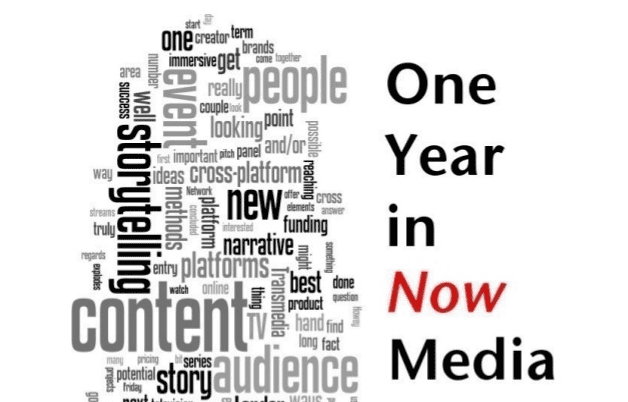Last week I published, for the second year in a row, a wrap up of my blogging activities for the past twelve months. It goes by the title “One Year in Now Media” (embedded below) and focuses heavily on the possibilities and challenges a media world knitted together by multiplatform storytelling brings.
The aim of the publication is to act as a resource for producers, creators, commissioners and researchers in the fields of multiplatform and transmedia storytelling, with a definite bias towards the TV industry. I interviewed a fair amount of knowledgeable people for the publication, and thought I’d share some pertinent quotes. Enjoy!
Transmedia has been a buzzword for quite some time now. There is relevance in the term still, but as Jeff Gomez, CEO of Starlightrunner Entertainment, puts it:
“I’m not precious about words. Words are just sounds in the air, subject
to your interpretation. You don’t like a word I’m using, well all I ask is that you get the gist of what I’m saying and if you find it useful, fantastic! If you despise the word “transmedia,” plug your own word for it into my sentence, but know that the word stands for a combination of concepts that is unique and meaningful.”
And there is a new crop of producers just entering the industry that have all of this integrated in their DNA, as Ian Ginn, producer, storyteller and educator at Hubbub Media tells us:
“This is the first generation of multi-skilled digital natives to have entered the industry, they grew up with the internet and games consoles and many had access to multimedia CD-ROMs when young. They are informed about core concepts, easily discuss where transmedia could be heading and the projects they are creating, and many have their own meaningful take on how they intend to work with transmedia.”
At the same time, there is a lot of debate and anxiousness about the financial viability of transmedia and multiplatform projects. Mike Monello is COO and partner at Campfire NYC:
“I don’t really see “transmedia” as a specific thing that can be packaged and sold, but rather as an approach to telling a story using all the tools and opportunities available to us. In that sense, the business model is a combination of the current (and future) business models associated with the platforms/tools/technologies utilised. […] Business models, or more broadly “value” is a core issue facing transmedia in 2013 and I’d like to see the practitioner community spend more time examining how creators are currently applying transmedia principles and what actual value these methods have, monetary and otherwise.”
There are a great number of pitfalls still, as the area is quite volatile. Chantal Rickards is the head of programming and branded content at MEC EMEA, and she sees a danger in overstretching the viewer:
“Two screen isn’t a dead cert yet. It has to be handled with care. It is only right for certain types of programming as anything that becomes overly distracting from the content will ultimately have an adverse effect for all concerned. It mustn’t disrupt the entertainment value of the content.”
In all of this, the audience is the key. Stephen Stokes is strategy director at Manning Gottlieb and would like to see a change in how the audience is taken into consideration:
“I think increasingly we need to look at things from people’s points of view (I know this sounds obvious, but it’s not always followed). Understand what their behaviour is first across this multi-platform world, and then work out what value we can give them to earn their attention, respect, consideration to purchase, sharing to their networks etc…”
There are even encouraging signs that Scott Walker, president at Brain Candy and heavily involved in co-creating with the audience, has noticed when it comes to sharing profits with the audience:
“I’m even seeing signs in the past couple of years that media companies are experimenting with value co-creation. One example is the Mann Company Store created by Valve for its Team Fortress 2 online multi-player video game. Valve used the online store to sell virtual, in-game goods for players to use in the game, and they invited anyone to submit their own original virtual goods for sale in the store. These effectively put user-generated virtual goods on the same “shelf space” as virtual goods created by Valve. The company paid out roughly $1M in revenue sharing over the first year to contributors whose goods were sold in the online store.”
There is a lot more where this came from in the publication, which is available for free on Slideshare!
Simon Staffans is a format developer for MediaCity Finland, and a regular contributor to MIPBlog. More on his own blog, here.




